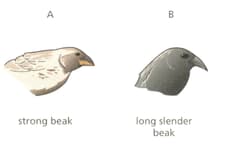MEDIUM
Lower Secondary Stage 9
IMPORTANT
Earn 100
Explain why identical twins look alike.

Important Questions on Variation and Inheritance
EASY
Lower Secondary Stage 9
IMPORTANT
Give two examples of inherited variation seen in cats.
MEDIUM
Lower Secondary Stage 9
IMPORTANT
Robert Bakewell is known for his work on selectively breeding in the s. He selectively bred cattle to produce a breed that ate less food and put on more weight than any other breed. Suggest why the process of selectively breeding is still popular across the world today.
MEDIUM
Lower Secondary Stage 9
IMPORTANT
Charles Darwin caught different types of finches on the Galápagos Islands in the Pacific Ocean. He brought them back to London where they were analysed by John Gould. Each species had a different type of beak. The diagram shows two of these finches. Complete the table to show:
- The letter of the finch best suited to each type of food.
- An explanation of how the beak is adapted to the food.

| Finch | Main food source | Explanation |
| Nectar from inside flowers | ||
| Seeds that need to be crushed |
MEDIUM
Lower Secondary Stage 9
IMPORTANT
Describe one similarity and one difference between selective breeding and natural selection.
MEDIUM
Lower Secondary Stage 9
IMPORTANT
Lemmings are furry rodents naturally found in the Arctic tundra. In a population of lemmings was taken from the Arctic to an area with a warmer climate. The lemmings were left to live and reproduce in the new area. The population of lemmings was revisited years later. Some information about the lemmings is shown in the table:
| Year | Average fur length of lemming(mm) |
MEDIUM
Lower Secondary Stage 9
IMPORTANT
A farmer wants buffalo produce a high milk yield. Describe how the farmer could use selective breeding to produce such animals.
